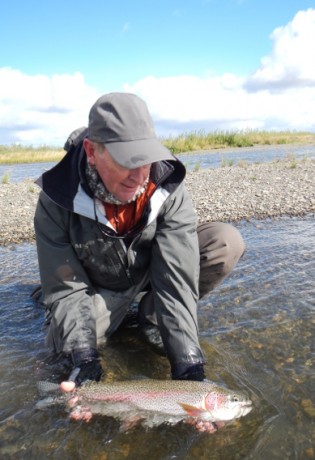
In this Episode of Deneki Chronicles, we explore the idea of fishing in high water. For the most part, a blown-out river is not a good thing for any fly angler. But we’re here to tell you, that it is not the end of the world. Have a read.
Whether early-season run-off or late season rain, fishing for trout can be challenging when the river comes up and the water becomes dirty. That’s not to say it can’t be done, though! Here are nine tips when targeting trout in high water.
- Go Fishing. Don’t let ‘the river’s blown out’ be an excuse to stay in. Some of the largest trout of the year are caught during high water, not to mention you’ll probably have the river to yourself. As long as it is safe to do so, get out there! You’ll catch more fish than if you stay home.
- Target Slower Water. When the river runs high, trout will seek refuge from the heavier current, finding lies where they can hold comfortably but still feed. Often this is far shallower than many anglers realize. Spend less time targeting faster water lies such as high banks and riffles, and concentrate more on slower water lies such as slow inside seams and back eddies or soft inside bends. Be on the lookout for slower water away from the heavy current and fish there.
- Expect More Than One Fish. Trout are often more concentrated during high water. So, if you hook a fish and the situation allows, cast back in there! There’s a good chance there’s more to come.
- Fish Big Flies. High dirty water means low visibility for trout. Therefore it’s important to fish flies large enough to grab the fish’s attention. Think large streamers designed to push a lot of water, big rubber-leg style nymphs, or oversized flesh or egg patterns.
- Fish Gaudy Flies. Although the fly color will vary from river to river, darker colors tend to be more visible in colored-up water. However, don’t underestimate the power of contrast in your flies. Darker flies with a ‘hot spot’ of color or a touch of flash can help grab a fish’s attention in stainy water, particularly on a sunny day.
- Fish Heavier Tippet. Trout are far less likely to inspect your fly in dirty water. Take advantage of the decreased visibility and go up a tippet size.
- Fish the ‘New Water.’ As water levels rise, a new habitat is created along the banks. Be sure to fish these new potential trout lies (particularly those on the inside banks), even if they didn’t have water in them last week.
- Fish Side Channels. Smaller side channels or tributaries of the main river are usually clearer than the main current, especially if they are spring-fed. Trout will often push into these smaller channels to escape the high silty water of the main river.
- Have Faith. Remember, regardless of how high or dirty the water is, trout cannot ‘leave’ the river, nor can they afford to stop feeding entirely. Keep that in mind the next time the river pops.
Leave a Reply